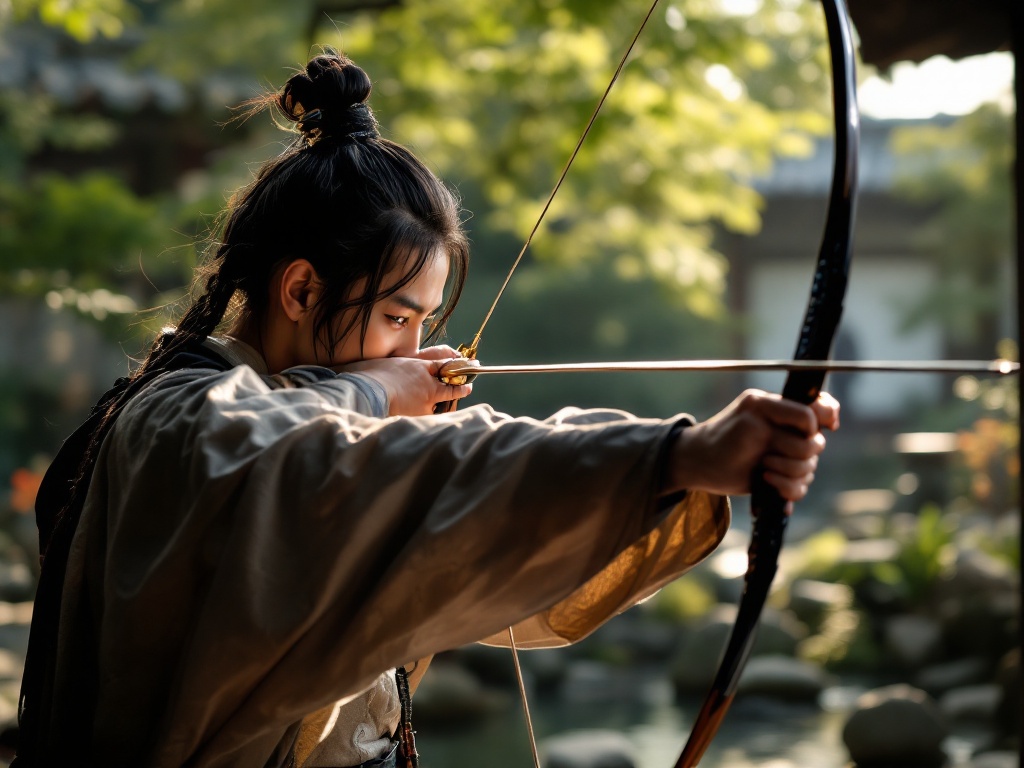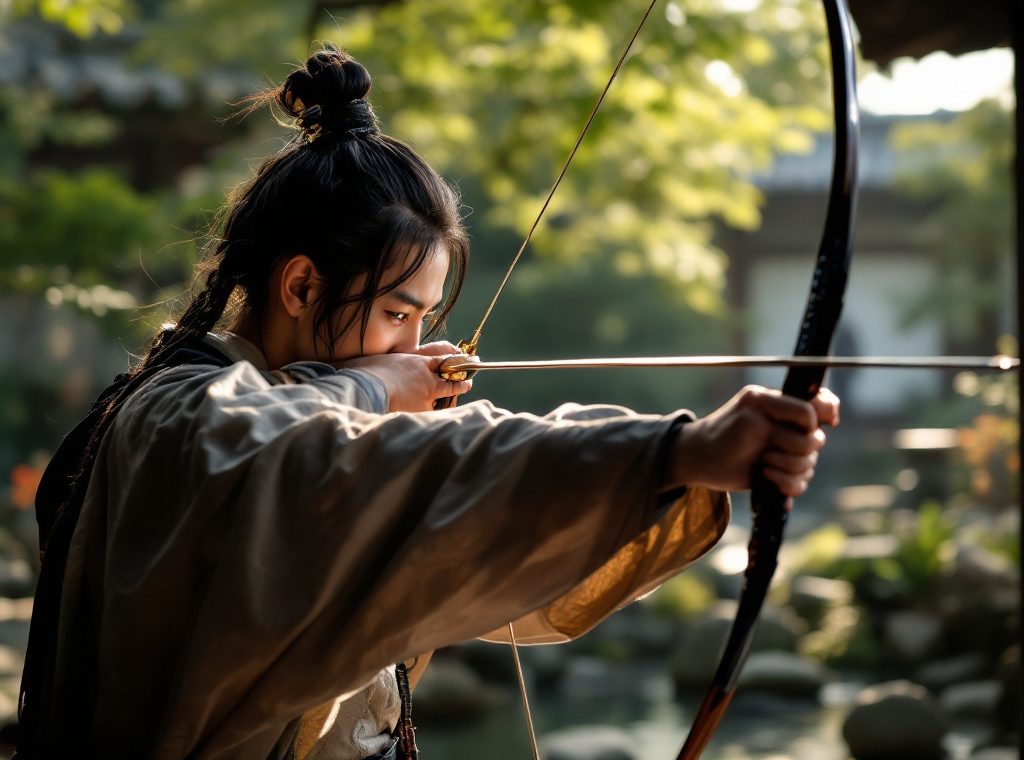Kyūdō: The Beauty of Japanese Archery
Discover Kyūdō, the Japanese art of archery where hitting the target is just the beginning. More than a sport, Kyūdō is a journey of self-discovery, blending Zen principles with the grace and precision of a centuries-old martial art. Explore the rich history of the yumi (bow), from its samurai battlefield origins to its role in modern spiritual practice. Learn about the eight stages of Hassetsu, the core principles of Truth, Goodness, and Beauty (shin, zen, bi), and the significance of rituals and etiquette. Begin your exploration of Kyūdō today and uncover the path to inner peace and self-mastery.
Important information

- Kyūdō is a traditional Japanese martial art focused on spiritual and personal development, not just hitting a target. It emphasizes harmony of mind, body, and spirit.
- Derived from kyujutsu (battlefield archery), Kyūdō evolved into a practice of self-cultivation. It uses the yumi (bow) and ya (arrow) for personal growth, not warfare.
- Core principles include truth (correct technique), goodness (moral conduct), and beauty (harmonious movement), all rooted in Zen Buddhism and Shinto traditions. Mindfulness and proper etiquette are essential.
- The practice follows “Hassetsu,” an eight-stage shooting sequence. Key elements are Ashibumi (stance) and Tenouchi (grip), which are vital for balance and accuracy.
- Kyūdō has a global presence, with international competitions and federations promoting its practice and cultural exchange worldwide.
Kyūdō: A Fusion of Art, Skill, and Spiritual Growth
Kyūdō, a traditional Japanese martial art, gracefully combines skill, spiritual growth, and aesthetics. At its core, this practice emphasizes the archer’s inner harmony—a synergy of bow, arrow, and target. Often hailed as the purest martial art, Kyūdō prioritizes mental and spiritual development, distinguishing it from other disciplines.
Understanding Kyūdō as a Martial Art
Kyūdō, a traditional Japanese martial art, is more than simply hitting a target with a bow and arrow. It’s a practice focused on spiritual and personal development, where practitioners seek harmony between mind, body, and spirit. This unique path to self-discovery is gaining international popularity, with a growing number of people embracing Kyūdō worldwide.
Kyūdō as a Journey of Self-Discovery
Kyūdō is more than just archery; it’s a journey of self-discovery. While hitting the target is important, the ultimate goal is achieving inner peace. Each arrow released contributes to personal growth, fostering mindfulness and introspection. Through the practice of Kyūdō, individuals embark on a profound path of self-understanding.
The Historical Context of Kyūdō
Kyūdō, the Japanese art of archery, is steeped in tradition, with its roots intertwined with hunting, warfare, and ancient ceremonies. As Japan transitioned towards peace, the bow’s function evolved from a weapon of war (kyujutsu) into a tool for self-discovery and spiritual growth. This transformation gave rise to kyūdō, a practice that cultivates discipline and mindfulness through archery.With this shift from kyujutsu, the martial art, to kyūdō, the bow’s role changed dramatically. Once essential for combat, it became a conduit for ceremonial and spiritual practices, reflecting Japan’s changing cultural values. The Japanese bow has served diverse purposes throughout history. It was used for hunting and warfare, featured in court rituals and games, and was central to various competitions. As peace became paramount, its purpose shifted once more, giving birth to kyūdō’s emphasis on self-cultivation and spiritual development. This unique discipline blends ancient tradition with the pursuit of personal growth.
The Evolution from Kyujutsu to Kyūdō
Kyujutsu, the precursor to Kyūdō, was a battlefield art focused on combat effectiveness. However, Kyūdō evolved from these martial origins into a practice emphasizing self-cultivation and spiritual development. This shift transformed its purpose from hitting wartime targets to fostering personal growth through the discipline of archery.
The Japanese Bow: From Warfare to Ceremonial Use
The Japanese yumi (bow) boasts a rich history, evolving from a potent weapon of war favored by samurai to a key element in rituals and ceremonies. This evolution underscores Japan’s emphasis on discipline and tradition, with the yumi symbolizing respect and honor. Today, Kyudo elegantly preserves this tradition.
The Philosophy and Principles of Kyūdō
Kyūdō’s philosophy centers around the pursuit of truth, goodness, and beauty (shin, zen, bi). Truth represents pure and correct shooting technique. Goodness encompasses courtesy and compassion, along with a strong moral compass that rejects all forms of aggression. Beauty emerges from the harmonious blend of truth and goodness, reflected in the archer’s actions and spirit. Deeply rooted in Zen Buddhism, Kyūdō cultivates mindfulness, focus, and tranquility. Each shot demands complete presence and intention, transforming the act of shooting into a meditative practice and a path of self-discovery. Similar to the Zen pursuit of enlightenment, the archer seeks the perfect shot.
Truth, Goodness, and Beauty: Core Tenets
In Kyūdō, the pursuit of truth, goodness, and beauty (shin, zen, bi) is paramount. Truth embodies sincerity and precision in every action. Goodness reflects strong moral and ethical conduct. Beauty manifests as elegant form and harmonious movement. Intertwined, these principles cultivate self-improvement through dedicated practice.
Spiritual Aspects and Zen Influence
Kyūdō, the Japanese art of archery, is deeply rooted in Zen Buddhist principles. Mindfulness, concentration, and serenity are essential for each shot, demanding complete presence of mind and fostering a meditative state. This echoes Zen’s emphasis on living in the present moment. More than simply hitting the target, Kyūdō prioritizes the process itself, mirroring Zen’s path towards enlightenment. Shintoism also influences Kyūdō, adding ritual and reverence for the bow and arrow, which are considered sacred objects. The archer’s focus extends beyond the target to encompass the entire experience, from preparation to release. This holistic approach aligns with Zen’s focus on integrating mind, body, and spirit.
Principles of Shooting: Spirit and Rightness
In Kyūdō, the archer’s spirit is paramount. Right action arises from proper etiquette, guiding the archer’s every move. Purity of action and intention are crucial, forming the very essence of Kyūdō. Courtesy and respect are integral to each shot, with every arrow reflecting the archer’s inner state.
Kyūdō Equipment: The Essence of Yumi and Ya
Kyūdō practitioners use specialized equipment, primarily the yumi (bow) and ya (arrow). The yumi, towering over the archer, is crafted from bamboo, wood, and leather, boasting a unique asymmetric design. The simpler ya consists of a bamboo shaft, a metal tip, and stabilizing fletching. Essential accessories include the yugake (glove), oshiroi (powder), and tsurumaki (quiver). Each element plays a vital role in this traditional Japanese archery.
The Beauty and Artistry of the Yumi
The Japanese yumi, a longbow towering over the archer, is crafted from bamboo, wood, and lacquer. Its asymmetrical design, with an extended lower limb, is crucial for balance and reflects a deep connection with nature. More than a weapon, the yumi is art, merging function and craftsmanship. In Kyūdō, the yumi transcends its physical form, becoming a conduit for spiritual exploration. Drawing and releasing the arrow becomes meditative, shifting focus from the target to inner peace and self-discovery.
Kyūdō Gear: Arrows, Yugake, and More
Kyūdō, the Japanese art of archery, requires specialized equipment. The core components include the yumi (bow), ya (arrows), and yugake (glove). The yumi, constructed from bamboo and wood, is taller than the archer and has a unique asymmetrical design. Arrows, known as ya, are made of bamboo and fletched with feathers for precise flight. The three-fingered yugake protects the archer’s hand and ensures a smooth release of the bowstring. Traditional attire, such as the hakama (pleated, skirt-like trousers) and keikogi (jacket), allows for ease of movement while respecting Kyūdō’s heritage.
Kyūdō Techniques and Training
Kyūdō, the Japanese art of archery, is deeply rooted in the Hassetsu, an eight-stage sequence defining proper shooting form. Two vital components of this sequence are Ashibumi and Tenouchi. Ashibumi establishes a stable foundation through precise foot placement, while Tenouchi dictates the specific grip on the bow. Both are crucial for maintaining balance. Kyūdō practitioners aim for Seisha Hicchū, striking the target. True mastery, however, is achieved through Seisha Seichū, hitting the target not just accurately, but with impeccable technique and form.
The Methodical Sequence of Hassetsu
Ashibumi: The archer precisely positions their feet, establishing a stable foundation for the shot.
Dozukuri: A firm and balanced posture is established, ensuring stability and control.
Yugamae: The archer carefully draws the bowstring, initiating the process of loading the arrow.
Uchiokoshi: The bow is raised, aligning the shot towards the target.
Hikiwake: The bow and arrow are smoothly and controlledly drawn apart, building potential energy.
Kai: The archer reaches full draw, a moment of focused concentration and stillness before release.
Hanare: The arrow is released, propelling it towards the target.
Zanshin: The follow-through completes the sequence, maintaining focus and balance even after the shot.
Stance and Balance: Ashibumi and Tenouchi
Ashibumi, the stance, creates a stable base for accurate shooting, allowing the archer to aim steadily.
Tenouchi, the grip, enables a clean release, guiding the arrow’s trajectory.
Together, these principles enhance both the archer’s stability and accuracy, forming the foundation of Kyūdō mastery.
Shooting Skills: Seisha Hicchū and Seisha Seichu
In Kyūdō, Seisha Hicchū describes the archer’s focused mind and body—a centeredness crucial for success. From this concentration flows Seisha Seichū, the act of hitting the target. This achievement emphasizes proper technique and highlights the importance of mental discipline.
Kyūdō Etiquette and Rituals
Kyūdōjō etiquette emphasizes respect and discipline through specific rituals. Practitioners bow upon entering and leaving, maintaining quiet attentiveness to cultivate mindfulness. These respectful bows, known as *Rei*, express gratitude and humility. Cultivating *Kokoro*, the spirit or mind, requires focused awareness and proper etiquette, deepening the connection with oneself and the art of Kyūdō.
Kyūdōjō Etiquette: Rituals and Discipline
Kyūdōjō etiquette emphasizes rituals and discipline, fostering a respectful atmosphere. Practitioners adhere to specific procedures for entering and leaving the dōjō (training area), including bowing to the kamiza (the highest point) and fellow practitioners as a sign of respect. Maintaining silence and focus during practice minimizes distractions. Proper care of equipment, especially the bow (yumi) and arrows (ya), demonstrates reverence for Kyūdō and cultivates discipline and mindfulness, enriching the overall experience. Here’s a breakdown of key etiquette points:
Entering and Leaving the Dōjō
Bowing to the kamiza upon entering and leaving signifies respect for the tradition and the space. Bowing to fellow practitioners acknowledges their presence and shared commitment.
Maintaining Silence and Focus
Silence minimizes distractions, allowing practitioners to cultivate inner stillness and concentration, essential for Kyūdō practice. Focus enhances mental discipline and promotes a deeper connection with the art.
Equipment Care
Proper care of the yumi (bow) and ya (arrows) is crucial. This demonstrates respect for the tools of Kyūdō and fosters a sense of responsibility and mindfulness.
Overall Benefits
By adhering to these practices, practitioners create a harmonious environment that supports their individual and collective growth in Kyūdō, fostering discipline, mindfulness, and reverence for the art.
The Significance of Rei, Kokoro, and Mindfulness
Kyūdō, the Japanese martial art of archery, emphasizes respect, sincerity, and focus as central to self-improvement. Respect (Rei) guides interactions, both with others and the practice itself. Sincerity and focus (Kokoro), stemming from the heart and mind, foster mindfulness and present moment awareness, particularly crucial when shooting. These combined elements transform Kyūdō into a holistic, meditative experience, a journey of self-discovery that transcends mere archery.
The Aesthetic Connection: Kyūdō and Japanese Culture
Kyūdō’s aesthetic principles are deeply embedded in Japanese culture, sharing a close connection with the tea ceremony (chanoyu or sadō). Both emphasize precise, ritualized movements performed with mindfulness and grace, creating a serene atmosphere and fostering an appreciation for simplicity and beauty. Kyūdō also reflects broader cultural values such as discipline, self-cultivation, and the pursuit of spiritual harmony, which are essential to many traditional Japanese arts.
Kyūdō and the Japanese Tea Ceremony
Rooted in Zen, Japanese archery (Kyūdō) and the tea ceremony (chadō) emphasize mindfulness, precision, and a deep respect for tradition. The disciplined, self-aware movements of Kyūdō are echoed in the tea ceremony’s precise actions, both performed within a serene atmosphere.
Each practice cultivates harmony between the physical and spiritual, offering a path to self-discovery and aesthetic appreciation within Japanese culture. The archer’s steady aim, like the tea master’s careful preparation, fosters tranquility and focus. More than mere rituals, Kyūdō and chadō are pathways to inner peace.
The Cultural Significance of Kyūdō
Kyūdō, a cornerstone of Japanese culture, emphasizes discipline and self-improvement. Rather than prioritizing hitting the target, the practice cultivates mental and spiritual growth. The meticulously crafted yumi (bow) embodies both strength and flexibility, while the ya (arrows) represent focus and intention. Kyūdō’s emphasis on form and ritual reflects traditional Japanese values such as harmony and respect. This unique blend of physical skill and spiritual understanding makes Kyūdō a powerful path to self-discovery.
Learning and Mastery in Kyūdō
Kyūdō is a structured discipline where practitioners advance through a series of Kyū and Dan ranks, marked by formal evaluations called Shinsa. Beginners should first locate a local dojo and train under the guidance of seasoned instructors. Dedicated practice, coupled with thoughtful self-reflection, cultivates proper technique, mental focus, and a deeper understanding of Kyūdō philosophy.
Kyū Ranks
These encompass beginner and intermediate levels.
Dan Ranks
These denote advanced proficiency.
Shinsa, the formal examinations, assess a practitioner’s skill and knowledge, serving as milestones for rank advancement.
Within Kyūdō, four main schools offer unique approaches and teaching styles:
- Heki-ryū,
- Honda-ryū,
- Ogasawara-ryū,
- Yamato-ryū.
Kyūdō Ranking System: Kyū and Dan
Kyūdō practitioners advance through a ranked system of *kyū* and *dan* grades. Beginners start at the lowest *kyū* level and progress to increasingly higher ranks. Upon reaching the first *kyū*, they can then test for *dan* levels, demonstrating greater mastery and a deeper understanding of Kyūdō. Higher *dan* rankings signify further refinement of skill.
Shinsa: Testing and Evaluation in Kyūdō
Shinsa, a formal test in Kyūdō, evaluates a practitioner’s skills and knowledge. It measures progress and marks the path to advancement, helping archers improve and guiding them towards higher ranks.
Kyūdō Schools: Heki-ryū, Honda-ryū, Ogasawara-ryū, and Yamato-ryū
Kyūdō, Japanese archery, encompasses various prominent schools, each with unique techniques and philosophies. These schools include:
- Heki-ryū,
- Honda-ryū,
- Ogasawara-ryū, and
- Yamato-ryū.
One school might emphasize a specific stance, while another focuses on mental discipline. These diverse approaches enrich Kyūdō, offering practitioners various paths toward mastery.
Kyūdō Competitions and Global Reach
Kyūdō competitions gracefully blend athleticism, tradition, and spiritual development. The prestigious All Japan Kyūdō Taikai, overseen by the All Nippon Kyūdō Federation, is a significant national tournament. On a global scale, the International Kyūdō Federation hosts the World Kyūdō Taikai, fostering international camaraderie and cultural exchange. Attracting competitors from around the globe, both events highlight Kyūdō’s expanding popularity and worldwide influence, a true testament to its enduring appeal.
Major Events: All Japan Kyudo Taikai and World Kyudo Taikai
Japan’s annual All Japan Kyudo Taikai is a prestigious tournament showcasing remarkable archer skill. Every four years, the World Kyudo Taikai further promotes this art internationally, fostering cultural exchange and highlighting high-level competition and sportsmanship.
International Popularity and Practice
Kyūdō, a distinctive Japanese martial art, enjoys a global following. This growth is fostered by the International Kyudo Federation (IKYF), which promotes and organizes the World Kyudo Taikai worldwide. Thriving Kyūdō communities exist in countries like the USA, France, Germany, and Brazil. Numerous universities and Kyūdō associations offer instruction beyond Japan’s borders. As a result, this ancient art form is being embraced by a growing international audience.














